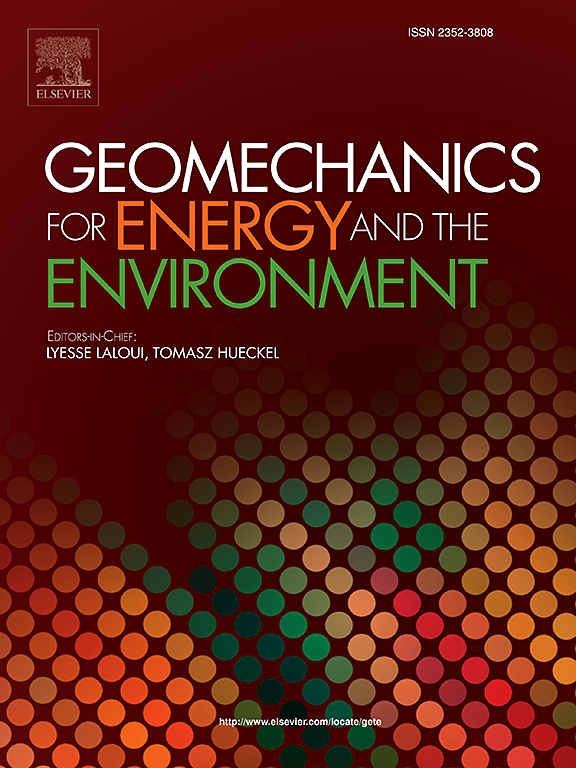Experimental and simulation study of cryogenic stimulation of granites from Akmola region in Kazakhstan
IF 3.3
2区 工程技术
Q3 ENERGY & FUELS
引用次数: 0
Abstract
The purpose of this research is to investigate the effects of elevated heating and cooling with liquid nitrogen (LN2) on the mechanical properties of two different granites from the Akmola region in Kazakhstan. While trends regarding behavior of treated samples are similar, the differences observed between the two compositions of granite are asserted to be due to the difference in quartz versus feldspar ratios and the contrast in coefficients of thermal expansion at heterogeneous grain contacts. The results showed that high initial temperature along with LN2 cooling increased the deformation of specimens leading to smaller peak stress values under load in both granite specimens. For granite 1, stress values decreased from a baseline value of 158.13 MPa to 123.24 MPa after heating to 400 °C and immersion in LN2; while for granite 2, the stress values decreased from 181.42 MPa to 118.33 MPa under similar conditions. There was a positive correlation observed between Young's modulus and the degree of thermal shock, whereas a negative correlation was noted for Poisson's ratio. The failure mode classification in Brazilian tests progressed with increasing initial sample initial temperature from Type I to Type III, indicating increasing complexity in rock integrity with larger thermal shock. Adding to the study’s novelty, numerical simulations were performed to investigate the distribution of stress in granite samples that were cryogenically treated utilizing von Mises stress analysis to monitor changes over time. The close match between the simulation results and the experimental data confirmed the model's reliability. These findings offer strong evidence in favor of the feasibility of increasing granite permeability by LN2-based treatments, which may improve the effectiveness and security of geothermal extraction techniques.
哈萨克斯坦Akmola地区花岗岩低温刺激作用的实验与模拟研究
本研究的目的是研究液氮(LN2)加热和冷却对哈萨克斯坦Akmola地区两种不同花岗岩力学性能的影响。虽然处理样品的行为趋势是相似的,但在两种花岗岩组成之间观察到的差异被认为是由于石英与长石比例的差异以及非均质颗粒接触处热膨胀系数的差异。结果表明,较高的初始温度和LN2冷却增加了试样的变形,导致两种花岗岩试样在荷载作用下的峰值应力值较小。花岗岩1在加热至400℃并浸泡LN2后,应力值从基线值158.13 MPa降至123.24 MPa;花岗岩2在相同条件下,应力值从181.42 MPa降至118.33 MPa。杨氏模量与热冲击程度呈正相关,泊松比呈负相关。巴西试验中的破坏模式分类随着初始样品初始温度从I型到III型的增加而发展,这表明随着热冲击的增加,岩石完整性的复杂性也在增加。为了增加这项研究的新颖性,我们进行了数值模拟,利用von Mises应力分析来研究低温处理的花岗岩样品中的应力分布,以监测随时间的变化。仿真结果与实验数据吻合较好,验证了模型的可靠性。这些研究结果为通过lng基处理增加花岗岩渗透率的可行性提供了强有力的证据,这可能提高地热开采技术的有效性和安全性。
本文章由计算机程序翻译,如有差异,请以英文原文为准。
求助全文
约1分钟内获得全文
求助全文
来源期刊

Geomechanics for Energy and the Environment
Earth and Planetary Sciences-Geotechnical Engineering and Engineering Geology
CiteScore
5.90
自引率
11.80%
发文量
87
期刊介绍:
The aim of the Journal is to publish research results of the highest quality and of lasting importance on the subject of geomechanics, with the focus on applications to geological energy production and storage, and the interaction of soils and rocks with the natural and engineered environment. Special attention is given to concepts and developments of new energy geotechnologies that comprise intrinsic mechanisms protecting the environment against a potential engineering induced damage, hence warranting sustainable usage of energy resources.
The scope of the journal is broad, including fundamental concepts in geomechanics and mechanics of porous media, the experiments and analysis of novel phenomena and applications. Of special interest are issues resulting from coupling of particular physics, chemistry and biology of external forcings, as well as of pore fluid/gas and minerals to the solid mechanics of the medium skeleton and pore fluid mechanics. The multi-scale and inter-scale interactions between the phenomena and the behavior representations are also of particular interest. Contributions to general theoretical approach to these issues, but of potential reference to geomechanics in its context of energy and the environment are also most welcome.
 求助内容:
求助内容: 应助结果提醒方式:
应助结果提醒方式:


